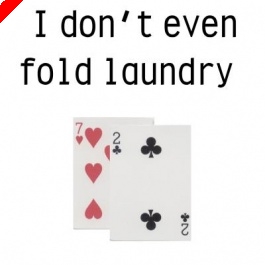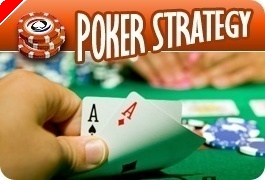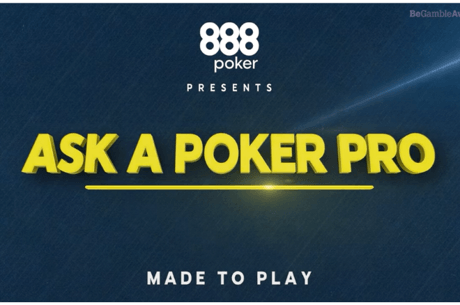Heads-up No Limit Hold'em: Pre-Flop Poker Strategy
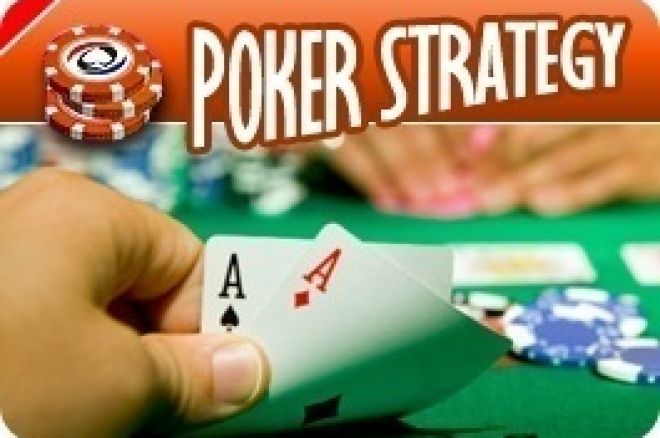
Today we will be discussing how to form a solid basis for fullstacked preflop
Heads-Up Hold'em poker
. Hereby we will be looking into playing on the button and playing in the big blind.
In my previous Heads-Up article I talked about how to adjust your game to shortstackers. In this article I will explain how to form a solid basis for fullstacked preflop Head-Up play. Throughout the article we will be assuming that both players have stacks of 100 big blinds in front of them.
As profitable as it is playing against shortstackers, it is even more profitable if this shortstacker suddenly sits down at a table with 100 big blinds. Maybe you spot a weak player with 100bb, or you just want to take on a regular. There are more than enough reasons to get into 100bb stacked poker.
Raising on the button
We are looking for a "standard range" that you can use against an opponent about whom you know very little. We also need to figure out the amount by which you raise.
Lets say its the first hand of a Heads-Up match and you are on the button with Q?4?. Should you raise this hand or not? In order to avoid these kind of dilemmas, it is recommendable to stick to a certain range. A good basis to start the match with would be to open roughly 70-80% of your hands to 3bb. You can simply go to Pokerstove (free program, google and download it if you don't have it yet) and type in 75%. This gives you the following range:
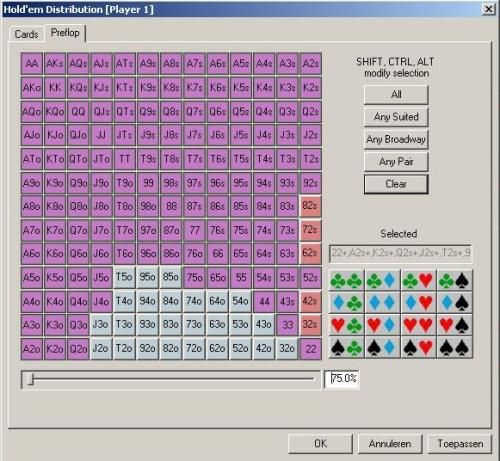
These are the best 75% of all hands, measured in strength against a random hand. Now, this doesn't necessarily mean that these are the best 75% of hands when playing with stacks of 100bb. If, for example, you would rather open with 32s than J4o, then you should definitely do so. Make your own selection of 70-80% of the hands that you prefer to play the most.
If you find this a little too loose you can remove some of the weaker hands form the list, or if you want to open more you can add the lowest suited connectors. You can start making some major adjustments as soon as you have gathered some information on your opponent. Does he fold a lot when in the big blind? Then just open 90, 95 or even 100% of your hands. Every time you raise, you invest 2,5 big blinds to win 1,5. Therefore, it only has to work out 62,5% of the time to make this move profitable. The situation becomes more complicated if your opponent often plays back at you in the big blind.
Adjusting your game to someone who often calls isn't that difficult. If he easily gives up the pot postflop, you can open a lot preflop, followed by a c-bet on the flop to pick up many of the pots. If he calls a lot postflop and makes moves, then make sure to only see the flop with stronger hands. You can open fewer hands and maybe start opening to 3,5-4bb if he keeps calling. With an opponent like this one you should raise more for value than to pick up pots.
When up against a player who 3-bets a lot, there are a number of things you can do:
�� Open less hands (65-70%)
�� Open smaller (to 2,5 or even 2bb)
�� Defend more hands (call 3-bets)
�� 4-bet bluffing
Opening fewer hands is a logical way to neutralise many 3-bets. You are making your range stronger by folding the weaker hands and having a better hand on average. This is, however, a very passive line to adopt and you are, in a way, accepting defeat. These 10% extra hands that you fold now are effectively equal to 15bb/100 that you are giving away to your opponent without much opposition. Therefore this line should only be adopted against opponents that are completely mental and against whom other moves are simply not going to work.
Opening smaller is another way of countering 3-bets. You keep the pot smaller and you give yourself a better price if your opponent adjusts the size of his 3-bet. You are now getting the chance to play a pot in position with a lot of money still left in front of you. Lets say your opponent 3-bets to 10bb and you min-raise. The next time he is likely to reduce his 3-bet to something like 8bb. If he keeps 3-betting to 10bb, then he is giving himself a worse price and you can fold more without it costing you a lot of money.
Defending more hands is an adjustment that is best made once you have some more information about how your opponent plays. Watch out for the type of hands he 3-bets with. If he 3-bets a lot of broadway hands you can easily defend every now and then with a hand like 98s. If he often 3-bets with suited connectors, then make the call with ATo. It is also essential that you know what to do with AT on a QT3 flop, so be careful when defending with these marginal hands. Good hands to defend with against an unknown range are hands that flop well or just strong hands, such as QJs, KQo, AJo. It can also be a good idea to only defend with hands like AA and KK every now and then instead of 4-betting.
The last adjustment you can make is simply to re-re-raise, in other words to 4-bet bluff. More about this later.
Playing in the big blind
Playing in the big blind is more difficult than playing on the button. The biggest problem is, of course, that you are always out of position, which automatically gives you a great disadvantage. Therefore I would recommend to play a lot tighter in the big blind than you do on the button. If someone opens 100% of his hands to 3bb and you have Q?7?, you might say: "I have a hand that has 51% equity against his range and I'm getting 2:1 to call". But because that hand is very difficult to play postflop, it is still better to just fold the hand preflop.
Just like having a standard strategy for the button, it is also helpful to have a plan for the big blind. A good idea might be to defend about 30% of your hands if you know nothing about your opponent. From these 30% you can 3-bet about half and just call the other half. Bear in mind that when your opponent opens 100% of his hands, you want to aim for about 37,5% without making any drastic changes to your game, otherwise your opponent can make a profit by simply raising every button. In practise it is, of course, logical to incur some losses in the big blind and make up for this on the button. But minimising your losses in the big blind has the same positive effect on your winrate as increasing your winnings on the button.
When looking at the best 30% of hands with Pokerstove, you will see that here it is a little more essential for you to make some adjustments for yourself. For example, K4 is not really a playable hand against a good opponent, while 89s is a hand you might not want to lay down that easily.
Here is an exampleofagood,playablerange:
22+,A2s+,K8s+,Q9s+,J8s+,T8s+,96s+,86s+,75s+,64s+,54s,A7o+,K9o+,Q9o+,JT
o,T9o
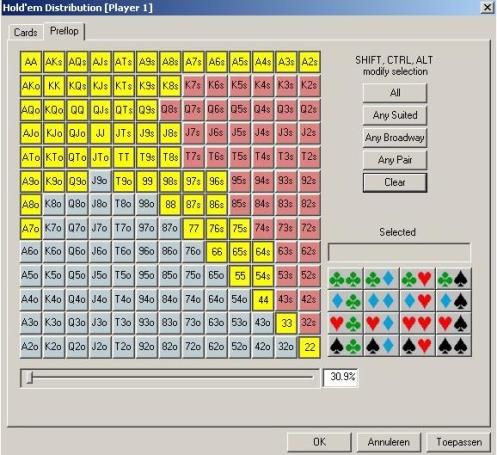
Once you have decided on which hands to defend your big blind with, you need to decide with which hands to call and with which hands to 3-bet. You can start off by 3-betting some no-brainers, like TT+, AQ+. You might also want to 3-bet AJ, ATs, KQ and KJs for value, because your opponent will often call with less and you can flop a strong top pair to play for stacks with. However, this range is only 7.7% of your hands, and when up against an opponent that pays attention, this is easily exploitable, as you will hardly get any action on your strong hands. Therefore I would recommend to have more variation in your 3-bet range.
While you can still 3-bet KJs for value, this becomes more tricky when 3-betting a hand like QJo. If you flop a Q or a J and you get all your money in the middle, chances are high that your hand is behind. A 3-bet here would therefore not be for value, but QJo plays far too well against the button range of every player to fold it. It would be best to just call with this hand. You can see where this is going: a 3-bet range from a good player will consist of value-hands and bluffs, and the hands in between he will flatcall. Therefore you should add some of the lowest suited connectors to your 3-bet range. This way you stay unpredictable. Other hands that are good to 3-bet with are low pairs (22-66), because it is hard to play these hands profitably postflop out of position against a good opponent.
An example of a well-balanced 3-bet range is:
TT+,66-22,ATs+,KJs+,T8s,97s-96s,86s,75s,64s+,54s,AJo+,KQo,T9o
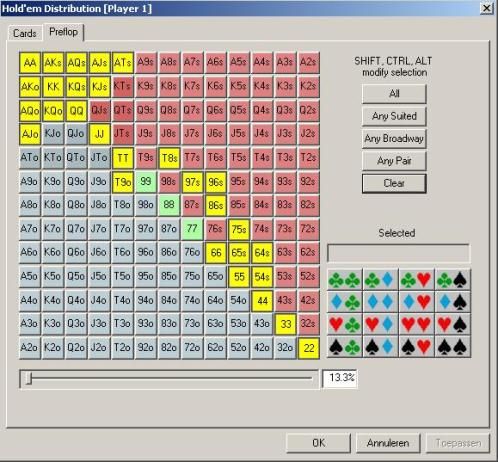
These are 13,3% of your hands, consisting of 7,7% value-raises and 5,6% bluffs. Because the average player will 3-bet too often, this is a good starting point. Furthermore, as always in No Limit Hold'em, but especially when playing Heads-Up, it is important to adjust to your opponent.
An important concept is to not only adjust your 3-bet percentage but also the hands with which you 3-bet. Does your opponent call a lot of 3-bets, then just flatcall some suited connectors and 3-bet with KJo, KTs, AT and A9s. Reducing your 3-bet frequency and to stop 3-betting your suited connectors all together is also a good option against a weak opponent who doesn't realise what your are doing.
If your opponent folds to almost any 3-bet, then remove AA, KK and many weaker value hands from your 3-bet range and replace them with suited connectors. The reason for this is that you are now up against very strong hands if you get called, and you wouldn't want to have KJs in that situation. If someone always folds, you also don't want to waste your AA and KK and only pick up pots of 4bb. Add hands like T7s, 74s, 43s and similar hands to your 3-bet range, hands with which you will be happy to pick up the 4bb. Another good idea would also be to increase your 3-bet frequency. If your opponent just keeps on folding, it is often a good idea to 3-bet about 25% of your hands or even more until your opponent adjusts his game.
The size of your 3-bet is also very important. If your 3-bet isn't big enough, your opponent can easily call and make postflop life very hard for you in position, but when 3-betting too big you risk too much to pick up too little. The general size against a 3bb open-raise with stacks of 100bb would be around 10-11bb. When raising to 10bb you risk 9bb in order to pick up 4. This would have to work 70% of the time in order to make this play profitable. This will not always be the case, so be aware of how often your opponent plays back at your 3-bets and adjust your frequency accordingly.
If the stacks become deeper than 100bb, slightly increase your 3-bets as well. If, for example, you 3-bet 10bb with stacks of 100bb, then 3-bet to 11bb with stacks of 125bb and 12bb with stacks of 150bb. Otherwise it will become far too easy for your opponent to defend his hand and play the pot in position. By not adjusting your 3-bet range to the stack sizes you are making your life unnecessarily complicated.
NB: This 3-bet theory is more flexible than your button-raise range. If you want to 3-bet for gameflow reasons or you spotted a timing tell, you can deviate from your normal range and base your play on your read. Although you should often try to stick to your normal range, it is not set in stone, so you do have the option to deviate from it when having certain reads.
4- and 5-betting
Just like with your button open-raises and 3-bets, it is a good idea to determine beforehand with which hands you are going to go all the way. Just like before this is a question of having a standard strategy and adjusting to your opponent.
A good starting point would be hands like TT-QQ/AK and AQs. If your opponent is playing very aggressive, you could also add AQo to the list. If you know your opponent goes all-in quite lightly, you can also add 99 to your 3- and 4-bet range and also take this hand all the way. Often you will quickly have an idea about how your opponent plays and you can immediately adjust your range. If a player 3-bets to 11bb, then you can 4-bet to 26-28bb. This gives you some room to bluff without forcing your opponent to call because of the odds. You are also leaving room for a 5-bet all-in without being committed yet. When 4-betting to 27bb, you are risking 24bb to win 13bb. This means your opponent will have to fold 65% of the time to make this play directly profitable. Make sure to also adjust your 4-bets to stacksizes to not give your opponent the right odds to call.
Although 4-betting is often very situation-specific, it does make a difference with what kind of hands you 4-bet. You wouldn't want to 4-bet with a hand that is strong enough to call a 3-bet with, but is too weak to call a 5-bet all-in with. When 4-betting, use the strongest and weaker hands of your range. You have a wide choice of weak hands, but the best of your weak hands are hands like K5o and A3o, purely because of the Ace and the King in your hand. These cards make it less likely that your opponent has an Ace or a King in his hand, which are obviously the majority of hands with which your opponent will be going all-in.
It is a good idea to keep AA and KK out of your 4-bet range against a player who doesn't go all-in that easily. This is because there is a lot of value in just calling with these hands and playing a postflop pot that starts off with 20bb. This balances out your range for calling 3-bets, as well as your range for making 4-bets. If a player goes all-in very lightly, on the other hand, it is of course a good idea to 4-bet your monsters and wait for his 5-bet.
The 5-bet bluff is something you should use sporadically. Not every player 4-bet bluffs, so there obviously wouldn't be much point in 5-bet bluffing against a player who doesn't 4-bet bluff. But sometimes you will find yourself in a situation where you can 5-bet bluff. If you often 3-bet, then the first 4-bet will more often be a bluff than a value 4-bet. Often the timing can also give you an indication of whether your opponent is bluffing or has a hand with which he wants to go all-in. If a player 4-bets very quickly, the chance is high that he is just sick of your 3-bets and has decided to play back at you even before you 3-bet. He would also need to take some time to think about what to do with AA or KK. In a situation like this you could therefore 5-bet bluff as long as your opponent has left you some leeway with his 4-bet. Here it is also a bonus when holding an Ace or a King in your hand, as they give you extra equity if you do get called, and the chance is smaller that he has a premium. Although there aren't many Aces and Kings in your 3-bet range, you can easily use AT for a 5-bet bluff.
Here is an example-hand to demonstrate how a 5-bet bluff works:
Full Tilt Poker Game #10852419747: Table Worron (deep hu) - $0.50/$1 - No Limit Hold'em - 11:59:03 ET - 2009/02/26
Seat 1: Hero ($257)
Seat 2: Villain ($100)
Villain posts the small blind of $0.50
Hero posts the big blind of $1
The button is in seat #2
*** HOLE CARDS ***
Dealt to Hero 4?3?
Villain raises to $3
Hero raises to $10
Villain has 15 seconds left to act
Villain has requested TIME
Villain raises to $25
Hero raises to $257, and is all in
Villain adds $25
Villain folds
Uncalled bet of $232 returned to Hero
Hero mucks
Hero wins the pot ($50)
*** SUMMARY ***
Total pot $50 | Rake $0
Seat 1: Hero (big blind) collected ($50), mucked
Seat 2: Villain (small blind) folded before the Flop
Lets say your are getting 4-bet for the first time and your opponent is a good regular. Calling is not an option here so you need to either fold or 5-bet. With an all-in you risk 90bb to win 35bb. Lets say villain 4-bets and calls an all-in with AK, AQ and TT+, then you still have 29,8% equity. If your opponent bluffs here 70% of the time, you will win (0,7*35)+((0,298*200)-(0,702*200))*0,3 = 0,26bb with this all-in.
The first number is the amount of times you will pick up the pot preflop (70% of the time, times 35bb), the second number is the amount of time you will win after getting called, the third number is the amount of times you will lose the hand after a call, and the fourth number is the 30% of the time you will get called. It therefore depends greatly on your read. If your opponent bluffs more than 70% of the time in this example, this move would be profitable, but if he bluffs less than 70% of the time, your 5-bet bluff is �CEV.
Even if your opponent bluffs less than 70% of the time it isn't that bad to make a mistake one time, as he is sure to think twice before 4-betting the next time. You can hereby make up for your losses by being able to 3-bet more freely later on in the match.
Bear in mind that these kind of moves bring great variance with them, so don't start doing it too often and avoid it if you are under-rolled or simply don't like to gamble. Even though this move is +EV, you can still get called a couple of times and lose the pot.
Summary
In this article we discussed how to behave preflop in No Limit Hold'em Heads-Up matches. We covered different strategies you can use and how to adjust your game to different strategies of your opponent. If you have any comments or questions, please feel free to address these on the forum.
Success at the tables!
